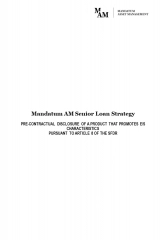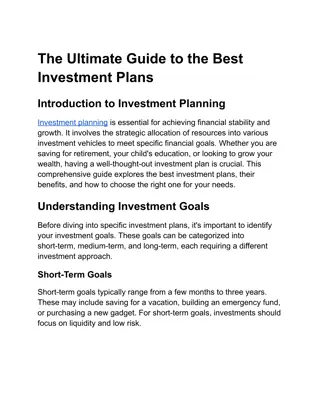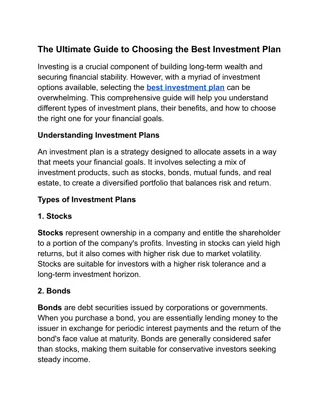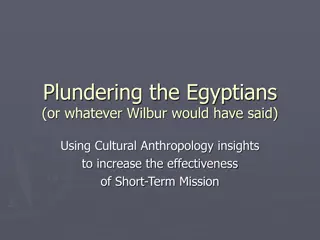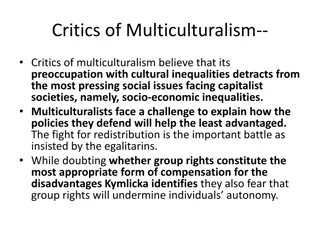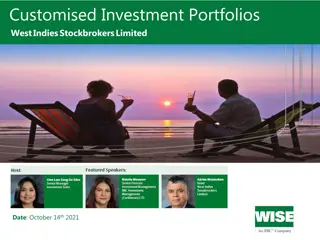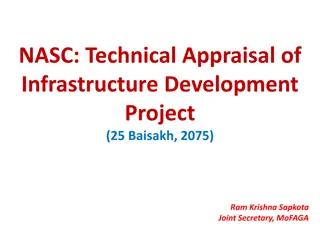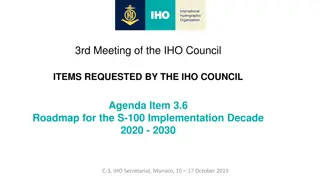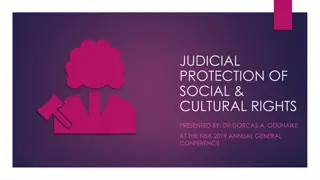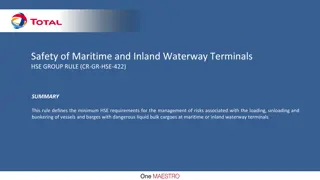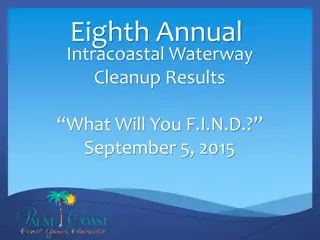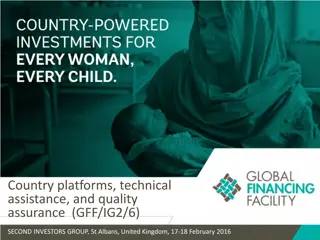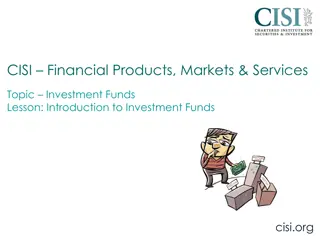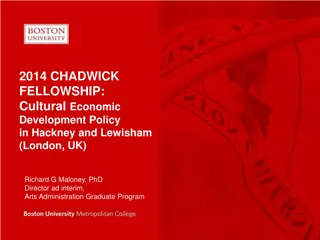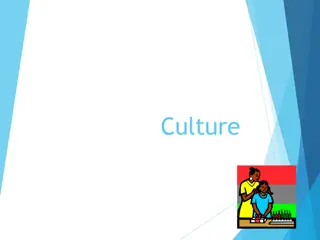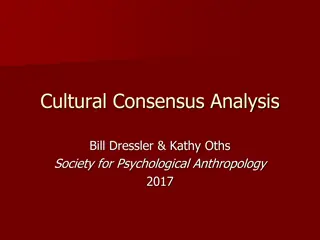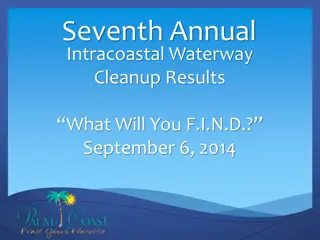Enhancing Social and Cultural Benefits of Waterway Investment through Design Principles
The project focuses on tracking the social and cultural benefits of waterway investment, with an emphasis on improving resource conditions to support recreation and cultural heritage. Key design principles include setting long-term targets, tracking progress, and focusing on tangible results. The project also aims to engage communities, increase awareness, and promote collaboration to achieve its objectives.
Download Presentation

Please find below an Image/Link to download the presentation.
The content on the website is provided AS IS for your information and personal use only. It may not be sold, licensed, or shared on other websites without obtaining consent from the author. Download presentation by click this link. If you encounter any issues during the download, it is possible that the publisher has removed the file from their server.
E N D
Presentation Transcript
Tracking social and cultural benefits of waterway investment Dr Tamara Boyd, INtrinsic SCOPE Pty Ltd BRISBANE, AUSTRALIA | 18 - 20 SEPTEMBER 2017 MANAGED BY
BRISBANE, AUSTRALIA | 18 - 20 SEPTEMBER 2017 MANAGED BY
Design principles Identify how works can achieve changes in resource condition which support social and cultural values Set long-term targets and system trajectories Track progress towards both objectives and outcomes Complement existing waterway management tools Find measures which can be practically resourced Focus on tangible results BRISBANE, AUSTRALIA | 18 - 20 SEPTEMBER 2017 MANAGED BY
Resource Condition of the resource (waterway, cultural heritage site or public infrastructure) is improved or maintained to support: Recreation values Cultural & heritage values Changes to the resource impacting: Amenity Accessibility Cultural heritage Biophysical/physical: Environmental works e.g. vegetation, weed control, rubbish removal, water regime Structural works e.g. visitor facilities, fence, bollard, road or crossing, waterway structure Social state Communities are better positioned to contribute to the resource condition objective e.g.: Active & engaged communities Informed & aware communities Project objectives Changes to the social state impacting: Awareness, skills Collaboration Management outcomes Non-biophysical: Result of activities generally related to people s involvement Engagement events Publications Agreements or partnerships Outputs BRISBANE, AUSTRALIA | 18 - 20 SEPTEMBER 2017 MANAGED BY
Project Objectives Indices for the site s capacity to support activity Recreation Capacity Index and/or Cultural and Heritage Capacity Index An increase suggests potential for enhanced activity (through improved condition of the physical resources supporting such use) A maximum score is not the aim. Indicators and their trajectory recognise a site s unique context BRISBANE, AUSTRALIA | 18 - 20 SEPTEMBER 2017 MANAGED BY
Recreation Capacity Index Two measures and 5-point ratings for components: 1. On and In Water = Rec fishing, non-motor boating, motor boating, swimming, camping* 2. Beside Water = Tracks, sightseeing, picnics and barbecues, hunting, environmental volunteering Index is the sum of the activity metrics as a % of the total possible score (25) BRISBANE, AUSTRALIA | 18 - 20 SEPTEMBER 2017 MANAGED BY
AVIRA Metric Beside water activity (picnic/barbecue) Alternate Metric Beside water activity (picnics and barbecues) Value Score Descriptor Value Score 5 Descriptor 5 Designated picnic/barbecue area with facilities able to sustain larger numbers e.g. multiple barbecues and picnic tables, shelter, toilets, play equipment, car park Designated picnic/barbecue area with facilities able to sustain moderate numbers e.g. barbecue and several picnic tables, near toilets and car park. Robust enough to let visitors bring more equipment and infrastructure. Designated picnic/barbecue area present No designated picnic/barbecue area present 4 0 3 Designated picnic/barbecue area with facilities able to sustain small numbers e.g. barbecue and single table. 2 Designated picnic area with facilities able to sustain small numbers e.g. picnic table, no barbecue. 1 0 Area able to support basic picnic e.g. seating or shelter. No designated picnic/barbecue area present BRISBANE, AUSTRALIA | 18 - 20 SEPTEMBER 2017 MANAGED BY
New Metric Environmental volunteering Value Score 5 Descriptor Multiple (>3), active community groups and networks* regularly contribute to maintaining or improving the site OR 80-100% of the target audience ** are consistently engaged in environmental activity across the site 2-3 active community groups and networks often contribute to maintaining or improving the site OR 60-80% of the target audience are consistently engaged in environmental activity across the site One active community volunteer group or network contributes to maintaining or improving site condition OR 40-60% of the target audience are consistently engaged in environmental activity across the site 4 3 Informal community group or network present OR 20-40% of the target audience are consistently engaged in environmental activity across the site Community group present but have not undertaken any significant group activities or projects on the site OR <20% of the target audience are consistently engaged in environmental activity across the site No community group present or target audience activity * Both on-ground works and monitoring, funded and unfunded. Fluker posts would count as one group given they encourage community-based environmental monitoring ** e.g. farmers, Landcare groups, Waterwatch, Parks Victoria, Friends of groups, schools, Local Government, Indigenous community, NGOs, CoMs, Field and Game 2 1 0 BRISBANE, AUSTRALIA | 18 - 20 SEPTEMBER 2017 MANAGED BY
1A Recreation Capacity Index: Beside Water Activity scores: Pre-works Target No works Benefit 1 3 1 2 Tracks 3 3 3 0 Sightseeing 0 2 0 2 Picnics and barbecues 4 4 4 0 Hunting 3 4 1 3 Env l volunteering 11 16 9 7 Total score Indicator (%) 44 64 36 28 BRISBANE, AUSTRALIA | 18 - 20 SEPTEMBER 2017 MANAGED BY
BRISBANE, AUSTRALIA | 18 - 20 SEPTEMBER 2017 MANAGED BY
C&H Capacity Index Includes the following activity metrics: Site significance - Historic heritage Site significance - Indigenous heritage Cultural use of resources Connection to country Cultural heritage volunteering BRISBANE, AUSTRALIA | 18 - 20 SEPTEMBER 2017 MANAGED BY
BRISBANE, AUSTRALIA | 18 - 20 SEPTEMBER 2017 MANAGED BY
Management outcomes Change to the resource condition (supporting social/cultural values) expected to occur via: Amenity Accessibility Cultural heritage Satisfaction with tangible provisions will influence use of the site Assess target audience satisfaction with key waterway attributes BRISBANE, AUSTRALIA | 18 - 20 SEPTEMBER 2017 MANAGED BY
Amenity core attributes Vegetation extent Vegetation appearance (structure, diversity) Soil stability (as it affects water quality i.e. erosion or sedimentation) Rubbish removal Visitor facilities BRISBANE, AUSTRALIA | 18 - 20 SEPTEMBER 2017 MANAGED BY
BRISBANE, AUSTRALIA | 18 - 20 SEPTEMBER 2017 MANAGED BY
Templates developed Case studies underway with CMAs: Scoring Indicators to be tracked Target audiences Survey approach Benchmark surveys MER Plan targets Refine approach/guidance BRISBANE, AUSTRALIA | 18 - 20 SEPTEMBER 2017 MANAGED BY

